It’s here: the return to the new “normal”. Schools are prepping to go back to in-person learning, offices are moving away from working from home, and everyone’s schedules are rearranging again. We may not know what the new “normal” will be, but how do we prepare our pups for the definite change around the corner?
The biggest concern we see steadily increasing is separation anxiety. Dogs have become used to their humans being around all day and don’t get a lot of alone time. This sudden change can cause anxiety and distress until their owner returns. There are 4 main forms of distress for dogs separated from their owners: focus on getting away from something in the house, desire to get to something outside, reactions to external noises or events and a type of boredom. Your dog might urinate, defecate, bark, howl, chew, dig or try to escape to express their fear and distress.
You can alter their anxious (for both of you!) reaction by desensitizing your dog to your departure and teaching them how to relax. It is important to note that the goal here is not to teach your dog that you will always come back. Rather the goal is to keep your pet calm when they are left alone by teaching your pup that nothing bad happens when you leave. But it isn’t as simple as just expanding the time they are left alone bit by bit. It requires focus on altering your dog’s physical and mental well being and can be a several week and in some cases several month long process.
So where should you begin?
First, you need to be able to recognize the signs of anxiety in your pet. Because your dog can’t directly tell you they have anxiety, you’re going to have to watch their body language. Any of the following actions your dog displays can be a sign of stress and anxiety:
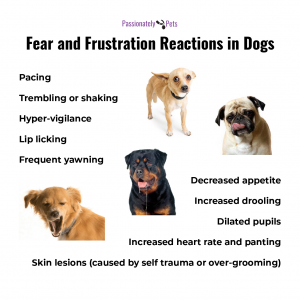
Here’s Jenna’s Leave The House Routine
- Get Up From Couch
- Get Coat from Coat Closet
- Put On Coat
- Grab Keys & Purse
- Give Penny a Food Stuffed Toy
- Exit the Home
- Lock the Door
Both fear and frustration reactions are common in dogs with separation anxiety, but these reactions don’t just appear suddenly once you have exited the premises. Your dog probably starts reacting when you begin your “leave the house” routine. In order to start making your dog feel comfortable when you are out of the house, you need to make them feel calm, comfortable and safe before you actually leave during all parts of your “leave the house” routine.
Identifying Your Routine
What does your “Leave The House” Routine include? Does it start when you get up from the couch? When you put on your shoes? When you grab your keys? When you walk toward the door? How many steps are there? Make a list of all the small things you do to prepare to leave your home. Trust me, your dog notices each and everyone and it is important to note which steps your dog is comfortable with and which ones create anxiety for them.
Discover Your Dog’s Comfort Level
Once you have your list, you can perform each task slowly, taking note of your dog’s reaction to each level of progression. You want them to remain comfortable, laying down in a relaxed position as you perform each task.
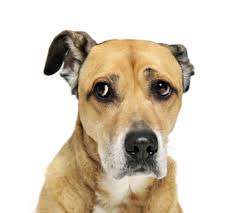
Using the example routine, if your dog remains calm when you stand up, you can try taking 1 step toward the coat closet, then 2, then 3. If still calm, you can place your hand on the closet door handle. The next step would be to open the coat closet door. If this causes them to show any of the anxious behaviors mentioned above – shift positions, sit up at high alert or come over to you – you should take note of their reaction and stop what you are doing. Note that every dog will have a different point in the routine that makes them uncomfortable. Once you’ve discovered this point for your dog, you can begin training.
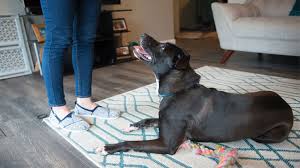
Create a Safe Space
Before you can start to work towards the door, you need to create a safe space for your dog where they can remain in a comfortable relaxed position for at least 2 minutes. This is where you want to encourage your dog to go when you eventually leave the house. A dog bed? A special mat? The couch? You decide.
Take Small Steps
You always want to begin training with your dog already relaxed in their space. Place their comfort mat 10 feet from the door that leads outside. Start with the Training Plan for a Relaxed Dog with the mat in this location. When your dog repeatedly completes Step 8 successfully, you are ready to make moves towards the door.
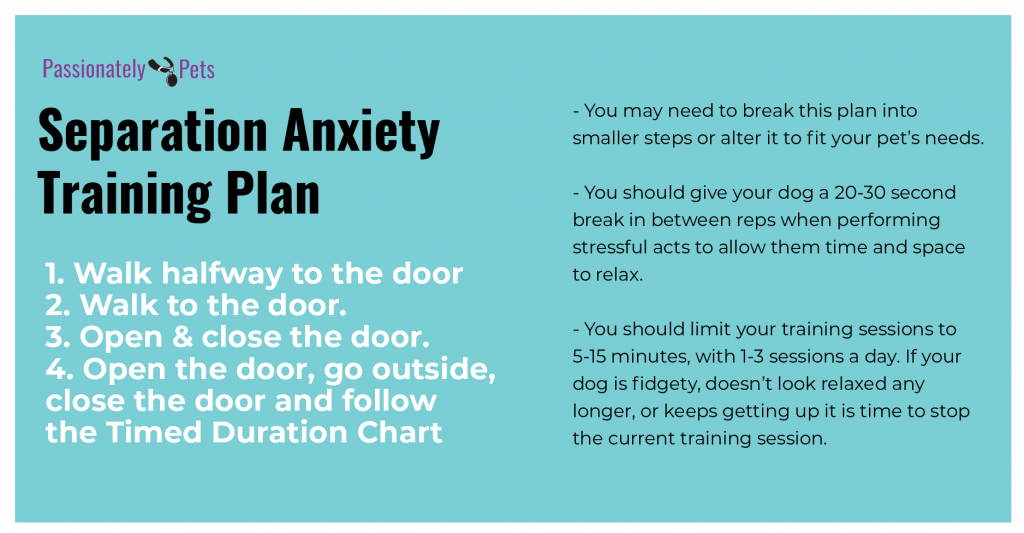
But those moves won’t be quick ones! You need to make sure your pet remains calm and can handle each progression. As with all training, Training Progression & Regression Rules apply, so you will perform at least 5 reps at each level and repeat, move on or move back accordingly. When your dog repeatedly performs Step 3 on the Separation Anxiety Training Plan successfully, you are ready to incorporate duration in Step 4. Here’s how:
You want to be able to remain outside of the home for a growing amount of time, building duration in seconds as follows: 1 3 5 10 15* 20* 30* 60* 120*
*Starting at 15 seconds, follow the instructions in the Timed Duration Chart.
So you will go out the door, close the door, count to 1, go back inside, return to your dog and give them a treat. Repeat for 5 reps and give them relaxation time on their mat for 20-30 seconds in between reps. When your dog is ready to progress: you will walk to the door, count to 3 and return to treat (as long as your dog remained calm and relaxed) for 5 repetitions, and so on up to being able to remain outside the door for 10 seconds consistently.
When you get to 15 seconds or more, we need to mix it up a bit because waiting 15 seconds or more between receiving treats will most likely stress your dog out. So once you have graduated to 15 seconds or longer, you’ll need to mix in shorter durations to keep them interested and relaxed. Reference the Timed Duration Chart Below for specifics.
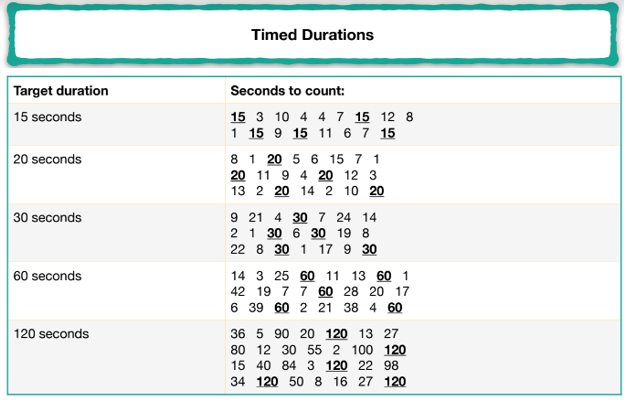
How Timed Durations Work:
Start with the 15 Second Box. Count to 15, return to your dog and give them a treat. Then count to 3 and give your dog a treat. Then count to 10, then 4, then 4, the 7 etc.
To know whether you can move up to the 20 second box, you’re going to look at the reps where you counted to 15. If your dog gets 4 or 5 of those correct and is still relaxed, you can progress to the 20 second box. If your dog gets 3 correct and is still relaxed, repeat 15 again. If your dog only gets 0-2 correct or is stressed, go back down to 10 seconds.
Create Your Own Training Plan
At this point, your dog has become comfortable with you leaving the house for a few minutes at a time. However, you have not yet introduced all the nuances that originally signaled to them that they were going to be left alone and then start panicking. They need to become comfortable with all of these steps as well. So take a look at your “Leave The House” routine and break it into small, measurable steps. This will be your next training plan.
You will want to start from the step in your routine your dog was comfortable with – the step right before the one that caused them anxiety – slowly working toward putting everything together and getting out the door. For example, you’ve already (hopefully) proved that your dog can remain relaxed as you walk about the house. But what happens when your hand touches the coat closet door handle? What about when you open the closet door? Pull out your coat? Put on your coat? Grab your keys? And so on.
Once you dog remains calm and relaxed during all steps in your routine, you can then work on slowly increasing the amount of time your dog feels comfortable alone.
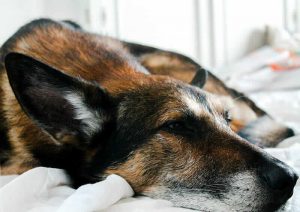
We are coming out of a year of being a homebody. Your pup has seen you leave only a handful (if at all) times during the day and normally it’s for a walk with them. We all need to start reminding them now that it is okay for us to be gone, that nothing bad happens while we are away and it doesn’t mean the end of the world. Starting this routine now will ensure happiness for you, your pup, and your furniture in the future!
Have questions about training? We are here to help! Let us know what’s going on in the comments.
Written and Contributed by: Jenna Gotch, Owner and Julia Nadovich, General Manager
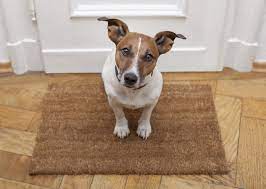




Leave a Reply